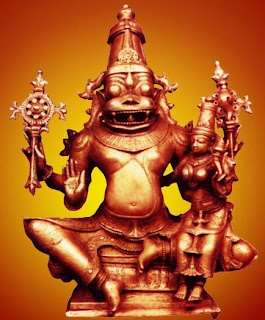shrIramaNikarakamala pUjita
chArucharaNa sarOja brahma samIra vANi
phaNINdra vINdra bhavENdra mukha vinuta
nIrajabhavANDOdaya sthiti kAraNane kaivalya dAyaka
nArasiMhane namipe karuNipudhemage maNgaLava .HKAS_01-01
Explaination 1 #
Jagganatha Dasaraya has done Managalcaharana with Sri Lakshmi Narasimha. Sri Madhwacharya has composed Sri Narasimha Nakha Stuti and in Mayavada Khandana he has invoked Sri Lakshmi Narasimha's grace.
On the same lines; Dasarayu has also invoked Sri Lakshmi Narasimha's grace.
Sri Lakshmi Narasimha is the roopa responsible (niyamaka) for swaroopa deha.
shrIramaNi-kara-kamala pUjita - One who is worshipped by Sri MahaLakshmi's (soft like)lotus like hands
SrI MahaLakshmi is called "padma haste"; there is nothing more pure than Sri MahaLakshmi's hands (other than Sri Hari).
Sri MahaLakshmi pressing Sri Hari's legs is like worshipping with the best lotuses.
chAru-charaNa sarOja - Extremely attractive feet like lotus.
Each and every word has been used with precision. "Charu-Charana Saroja" is a superior compliment to "kara kamala". Thereby showing taratamya; the article being worshipped is superior to the article being used for worship.
The worshipee is superior to the worshiper; Sri Hari is sarvothamma in every which way.
Sri Hari does not have swagata bheda vivarjita; no difference between limbs of Sri Hari everything is ananta.
Dasaraya has used similar style to SriMadhacharya ( LakshmiKanta Samantatopi naivesha tuste samam)
In Samudrika shastra; palms and feet being red are called lakshanas. This is the root of the custom of applying mehendi or gorantee to palms and soles of feet.
Brahma, Vayu devaru, Sesha, Rudra, Indra and all other deities are standing before Sri Hari and worshipping by singing praises.
Taratamya - Sri MahaLaxmi does pooje with her own hands, others by praying ( karakamala pujita-mukha vinuta )
All pooje to Sri Hari has to be done with Sri MahaLakshmi
Abhisheka - Abhisheka to Sri Hari is always through shanka as Sri MahaLakshmi is present in Shanka.
Mangalarti - All Mangalarti is done by keeping palm upwards because "Karagre vasate Lakshmi" so it is Sri MahaLakshmi who is doing Mangalarti not us.
During Naividya - "pariveshi teesham Streehi" It is Sri MahaLakshmi who is serving food to Sri Hari
Sri Krishnarpanamastu - While doing Sri Krishnarpanamastu we should always use Tulasi ( at least mentally)
brahma - ChaturMukha Brahma
samIra - Ira - to inspire (root of prerana) - samyakta ireti iti sameera - No body can inspire as much as Vayu devaru hence he is called samIra
vANi - Saraswathi/Bharati - Vaag Vani means Bharati Devi(amara kosha) so Vani can be used for both
phaNINdra - Sesh Devaru
vINdra - vI + Indra - Vi means Bird - VIndra - Garuda
bhavENdra - out of ekadasha Rudra; main in Parvati Patti hence called Bhavendra. Can also be split as bhava + Indra - Rudra Devaru + Indra
muka vinuta - singing praises ( vinuta - special praises )
nIrajabhavANDOdaya sthiti kAraNane -
Meaning 1#
nIrajabhavANDa - nIra+ja+bhava+Anda - jala(nira)+ja+bhava- Brahma Devaru + Anda = Brahmanda
nIrajabhava - one who was born on a Lotus from nabhi of Sri Hari
nIrajabhavANDA - Brahmanda
Meaning 2#
nIrajabhavANDA udaya - one who was born in lineage of Sri Brahma Devaru ( hiranyakashipu) + udaya ( his son- Prahalad)
stithi karane - one who gave stithi to Prahalad ( Sri LakshmiNarasimha )
udaya +sthiti kArane- creation + maintainance + main cause
kaivalya dayaka - giver of moksha
Note: the moksha giving is kept separate from Srushti, Sthiti because there are others involved in this. But giving of Moksha is exclusively with Sri Hari.
Vishnu rithiata mokashcya Vayuscha tadanugneya
Moksha is the best purusharta out of Dharma, Artha, Kama and Moksha. Therefore giver of Moksha is Sarvothamma.
nArasiMhane namipe karuNipudhemage maNgaLava -
namipe - Eshavasya Upanishad -15 - bhuyishtam te namuktim videma -
We can only pray to you O Sri Hari; there is nothing we can give.
With Bhakti Gynana we offer namaskara (bhuyistanti)
karuNipudhemage maNgaLava - Please shower your grace on us; maNgaLava ( moksha )
Explaination 2 #
In this explaination we shall see how the mangala shloka mirrors the mangala shloka of Sriman NyayaSudha
Narayana-Vasudeva-Sankarshana-Pradyumna-Aniruddha ( Pancha roopi paramatma ) - In any Alankara pankti consists of 5 brahmins to invoke the presence of 5 roops of Sri Hari in each.
Om ! Shriyah patye nitya-aganita-guna-maanikya-vishad-prabaaljallolla-soophat-sakalaa-vadya-tamase |
Jagat-janmasthem-pralaya-rachana-sheel-vapushe
namo-sheshamanaayaasmruti-hrydaya-diptaya haraye ||
Shriyah patye - Lakshmi Pati - Narayana Roopa
ara-means dosha - naraa ( no doshas; stri linga; feminine gender ) Lakshmi Devi - narayaha ayanam ayanam - narayana
nitya-aganita-guna - infinite gunas always
vishad-prabaaljallolla-soophat-sakalaa-vadya-tamase - always dosha vidoora
Jagta-janma (Creation) - Pradymna; sthem (Protection) - Anirudhha; pralaya (Destruction)- Sankarshana
Haraye - Hari - harata iti harihi - samsara bandham parhariti harihi- ( linga deha bhanga ) moksha pradayaka roopa - Vasudeva roopa
Comparison to HKAS 1.1
shrIramaNi - Narayana Roopa
brahma - Lakshmi/Chaturmukha Brahma
samIra - Vayu Devaru
vANi - Saraswathi/Bharati
phaNINdra - Sesha Devaru
vINdra - Garuda Devaru
bhaveNdra - bhavA + Indra - Rudra + Indra
nIrajabhavANDa - Brahmanda
Brahmanda udaya kAraNe - Pradyumna Roopa
Brahmanda sthiti kAraNane - Anirudhha Roopa
kaivalya dAyaka - moksha granting roopa - Vasudeva Roopa
nArasiMhane - pralaya roopa - Sankarshana and Narasimha Roopa are both Pralaya roopas. Sankarshana roopa does pralaya within brahmanda; Narasimha does pralaya outside brahmanda.
brahma - Lakshmi/Chaturmukha Brahma
samIra - Vayu Devaru
vANi - Saraswati/Bharati
phaNINdra - Sesha Devaru
vINdra - Garuda Devaru
bhavA - Rudra Devaru
INdra - Indra Devaru
mukha vinuta - all the above Gods ( includes people below them as well ) constantly praising gunas ( expresses the same emotion of Sri Hari being guna purna as defined by Sri Teekacharayaru )
Sri Lakshmi Narasimha is the upasya murthy of Sri Jagannatha Dasaru as well.
maNgaLa means "prashasta acharanam nityam; aprashastasya varjanam etatvi mangalam proktam"
After a religious discourse or vratha or reading of holy granthas; Mangala is performed to indicate that a very important or Prashasta work has been done till now.

